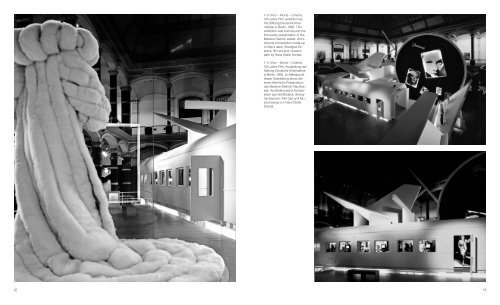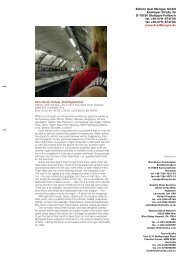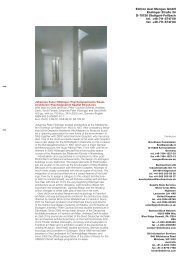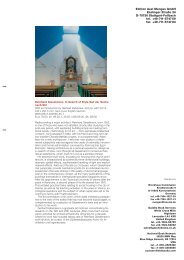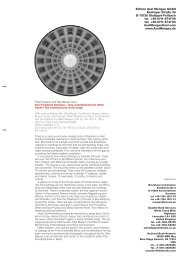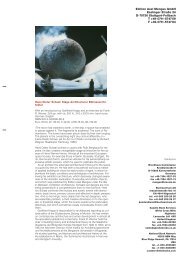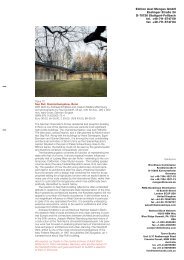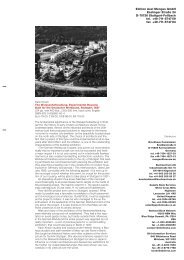Learning from Hollywood - Edition Axel Menges
Learning from Hollywood - Edition Axel Menges
Learning from Hollywood - Edition Axel Menges
Sie wollen auch ein ePaper? Erhöhen Sie die Reichweite Ihrer Titel.
YUMPU macht aus Druck-PDFs automatisch weboptimierte ePaper, die Google liebt.
Wolfgang Jacobsen<br />
Time-travel in time-space<br />
The Tower of Babel in Fritz Lang’s Metropolis is yesterday and tomorrow. It is a piece of urban<br />
fantasy. The hillside bungalow in Alfred Hitchcock’s North by Northwest, chained like<br />
Prometheus, is present becoming future. Film architecture has sign character. Whether it is<br />
reality, illusion or fantasy – film architecture plays a quite particular role. Film is a sign language.<br />
The first to come to mind are Metropolis and American urban Utopias in the films of the<br />
eighties and nineties, Blade Runner, of course. Attention is directed entirely at the mountains<br />
of skyscrapers, monstrous pyramidic excrescences of a city growing rampantly into the sky.<br />
Glorification and excessive elevation, visions that are often apocalyptic, or invocations of new<br />
worlds. Next to these are the Piranesi-inspired Carceri, apparently out of sight and yet in the<br />
centre, caves <strong>from</strong> a counter-world that is striving into the dark and often hides secrets of<br />
light. All this can sink into a great Atlantis flood – as in Fritz Lang, and almost as a metaphor<br />
for the existence of film architecture – in order to resurface years later as a deciphered new<br />
cipher in Kevin Costner’s Waterworld. Enigma.<br />
And we also catch sight of visions of Murnau’s Sunrise and Coppola’s One <strong>from</strong> the Heart,<br />
alternating between architectural designs of city and nature, in which the city appears as an<br />
amusement park and the countryside as a symbol of capricious life; nature proves to be as artificial<br />
as the glittering façades of the big small towns, which are craft and computer imagination<br />
– in fact sign language, condensed into pictorial worlds, eclectic or independently emotional<br />
and creative.<br />
Is film architecture real? Is architecture real? The hotel in Visconti’s Death in Venice or the<br />
sanatorium high up in Davos in Geissendörfer’s The Magic Mountain? Erich von Stroheim’s<br />
crazy Monte Carlo in Foolish Wives or the grandiose but false Carlton Hotel in the Chanel videoclip?<br />
Where are Lindenstraße and Berlin-Alexanderplatz? They are also connected by the<br />
wilful inventive intoxication of a man like Rotwang or Dr. Emmett Brown: Back to the Future.<br />
A look inside, just a detail: nature has been brought »home« in the urban space, preserved<br />
in props. It is unmoved, a silent guest: framed landscape images, postcards stuck behind mirrors;<br />
and of course the architecture of furnishings, that too is a landscape. In the city nature is<br />
static. It can be turned around, put away, substituted. Often such props mark the intersection<br />
of dream and reality.<br />
For a long time the look has bordered on the immeasurable, for a long time our understanding<br />
of nature has been occupied by the compulsive notions of a dream city. Michelangelo Antonioni’s<br />
The Red Desert transforms the landscape into an artful experiment with reality, at the<br />
same time a distorted image and a filmic puzzle. Film architecture is a mixtum compositum or<br />
Cinéplastique, not just an architecture of motion but architecture in motion. Futuristic worlds<br />
and mythic-archaic spaces are intended to become real and earthly, but also to be Science<br />
Fiction: time promises. What do Pasolini’s Oedipus Rex and Stanley Kubrick’s 2001 have in<br />
common, or Ridley Scott’s Blade Runner and William Wyler’s Ben Hur? They are projections<br />
of our wishes, that (are allowed) take to shape in ever new and varied worlds <strong>from</strong> the architects’<br />
workshops. And however near, however tangible film architecture ultimately may be, it<br />
also remains terrain vague, fleeting, a mere impression, rapid eye movement.<br />
It is very tempting to keep on being drawn into a métier where the built Utopias of reality<br />
are close on the one hand, but also remain a mere reflection, fantasy and fiction. Time-travel<br />
in time-space. Hovering between the garden landscapes in Ludwig Berger’s Ein Glas Wasser,<br />
Alain Resnais’ L’année dernière à Marienbad and Peter Greenaway’s The Draughtsman’s Contract;<br />
strolling through the claustrophobic interiors of an Expressionist film and the Americanstyle<br />
living-kitchen, with Doris Day at work at the cooker; escaping <strong>from</strong> the childlike and naïve<br />
fantasy universe of a director like Georges Méliès into the hermetic spaces of the James Bond<br />
worlds, in which floors, ceilings and walls can open and make the architecture disappear<br />
along with the people; and then escaping into the computer-animated data architecture of an<br />
architect like Zbig Rybczynski. Film is a laboratory of modernism. Film architecture is a laboratory<br />
of film modernism.<br />
On the trail of a historical cross-section of pictorial worlds – here looking in <strong>from</strong> the outside,<br />
not with the eye of a film architect but that of a cineastic architect, testing his own visions<br />
against the film, discovering ciphers, decoding signs, like an architectural Marco Polo<br />
on a journey of exploration in the pictorial space between reality and fiction. Hans Dieter<br />
7


